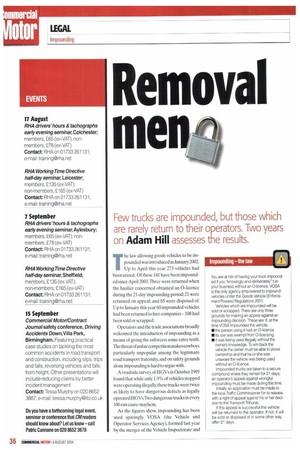Itemova
Page 38

Page 39

If you've noticed an error in this article please click here to report it so we can fix it.
Few trucks are impounded, but those which are rarely return to their operators. Two years
on Adam Hill assesses the results.
The law allowing goods vehicles to be impounded was introduced in January 2002. Up to April this year 273 vehicles had been seized. Of these 141 have been impounded since April 2003.Three were returned when the haulier concerned obtained an 0-licence during the 21-day impounding period; 21 were returned on appeal; and 85 were disposed of. 1:p to January this year 60 impounded vehicles had been returned to hire companies 108 had been sold or scrapped.
Operators and the trade associations broadly welcomed the introduction of impounding as a means of giving the enforcers some extra teeth. .111e threat of unfair competition makes cowboys particularly unpopular among the legitimate road transport fraternity, and on safety grounds alone impounding is hard to argue with.
A roadside survey of 110 Vs in October 1995 found that while only 1.9% of vehicles stopped were operating illegally,these trucks were twice as likely to have dangerous defects as legally operated HGVs.Two dangerous trucks in every 100 can cause mayhem.
As the figures show, impounding has been used sparingly. VOSA (the Vehicle and Operator Services Agency), formed last year by the merger of the Vehicle Inspectorate and the Traffic Area Network division of the Department for Transport. is the only agency with the power to impound under the 2001 legislation and only if a vehicle is being run without an 0-licence. When the legislation ‘k. as introduced the mere threat of impounding led to an increase in operators applying for 0-licences.
Although it offers what many would see as the ultimate sanction for an operator removing the means to make money impounding is not part of the criminal justice system. Instead it's based on the Driver and Vehicle Licensing Agency scheme for wheel clamping and detention of vehicles for which vehicle excise duty has not been paid.
Every time VOSA officials impound a vehicle they issue a fact sheet explaining what happens next (see panel). There are limited grounds on which you can appeal against an impounding decision to the Traffic Commissioner or. if that fails, to the Transport Tribunal. Relatively few vehicles have been returned to their operators so far. But operators who feel hard done by can take heart from the fact that the impounders do not always get it right. For example, Northern Irish haulier Sean McGuigan won £4,000 compensation after his truck was impounded by Customs and damaged in the process (CM 4 September 2003).
There may also be money available to you if your vehicle is sold or scrapped by the authorities, as the owner is entitled to receive its value less expenses. But the important words here, of course, are "less expenses".
As a VOSA spokeswoman explains: -Quite often the vehicles are so poor that they are often not worth anything anyway. The value when sold might be £300.Take the expenses out of that, such as the cost of impounding, and you might get £30. What he receives is unlikely to be what he paid for it. The best thing is to have an 0-licence in the first place."


































































































































































































